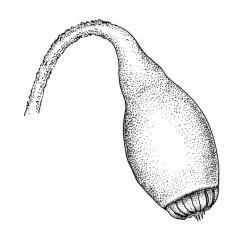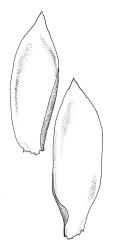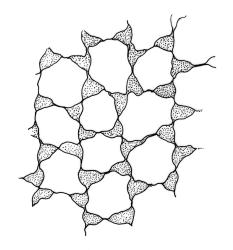- ≡ Hypnum jolliffii Mitt. in Wilson, Bot. Antarct. Voy. III. (Fl. Tasman.) Part II, 213 (1859)
- ≡ Stereodon jolliffii Mitt., J. Proc. Linn. Soc., Bot. 4: 87 (1859)
- ≡ Rhaphidostegium jolliffii (Mitt.) A.Jaeger, Ber. Thätigk. St. Gallischen Naturwiss. Ges. 1876–1877: 391 (1878)
- ≡ Rhaphidorrhynchium jolliffii (Mitt.) Broth., Nat. Pflanzenfam., ed. 2 [Engler & Prantl] 11, 428 (1925)
Plants bright green or yellow-green to copper, strongly lustrous, hygrophilous. Stems sparsely and irregularly branched, ± red, to at least 50 mm, with very sparse smooth rhizoids, in cross-section with several layers of incrassate outer cells and no central strand. Branches variable in length, to at least 15 mm, cuspidate, moderately flattened. Branch and stem leaves similar, loosely imbricate, ± spreading or moderately homomallous, elliptic, narrowed to a weakly clasping insertion, ± evenly tapered to a broadly acute apex, concave, plane at margins, finely denticulate or sometimes nearly entire at apex, entire below, c. (1.2–)1.5–1.9 × 0.6–0.7 mm, ecostate; mid laminal cells (upper third of leaf) vermicular, 48–72(–85) × 4–6 µm, smooth, narrowed at ends, not porose, becoming markedly shorter in leaf apex and longer (to >100 µm) in lower leaf; basal cells short, porose, and yellow; alar group strongly differentiated, with c. 3(–4) oblong cells in extreme angles strongly inflated and ± hyaline, grading quickly into laminal cells.
Autoicous in N.Z. material. Perichaetia often numerous on stems, the inner perichaetial leaves oblong and abruptly short-acuminate, strongly toothed at apex by projecting cell ends. Perigonia gemmiform and inconspicuous (<0.5 mm), scattered on stems and branches. Setae red-brown, mammillate-papillose near apex (rarely ± smooth), scarcely twisted, 6–11(–12) mm; capsules horizontal or pendulous due to curvature of upper setae or sometimes merely inclined, oblong-cylindric, symmetric, not narrowed at mouth and with a rough and ± protuberant neck when moist, weakly constricted below the mouth and with an irregularly protuberant/mammillate neck when dry, (0.8–)1.0–1.5 mm; stomata numerous, superficial, in clusters of 1–3 on protuberances in the neck; operculum long-rostrate from a conic base, ± equal the urn; exothecial cells ± isodiametric, strongly collenchymatous, appearing protuberant at low magnification when dry. Peristome as per genus; endostome with a high membrane, keeled and perforate segments nearly as long as the teeth, and single or paired nodose cilia. Spores (13–)15–18, rather variable in size in single capsule, green, smooth.
The strongly lustrous and robust nature of the plants and the flattened and cuspidate branch tips make this hygrophilous species distinctive. The ornamentation of the upper seta varies markedly, as does capsule orientation. Material with the upper setae very weakly scabrous and capsules inclined rather than horizontal to pendulous occurs at numerous localities, including Waipoua Forest, N Auckland L.D. (K.W. Allison 1866, CHR 629452), Little Barrier I. (L.B. Moore s.n., 2/1/42, CHR 613186), and Fifteen Mile Creek (CHR 428020). The neck of the capsule here can resemble that of Warburgiella leucocyta due to its wart-like protuberances.
Of the species treated here in Sematophyllum, only S. uncinatum commonly grows in similar stream-margin habitats; that species is rather dull in appearance, with acuminate and falcate leaves. It is a more common species and extends to much higher elevations.
NI: N Auckland including offshore islands (LB, GB), S Auckland (Coromandel Peninsula, Upper Kauaeranga Valley), Wellington (Mt Bruce, Kahuterawa Stream); SI: Nelson (Aorere Valley, Fifteen Mile Creek, Sharland Creek, Ohikanui River, Madmans Creek, Bullock Creek),Westland (s. loc.).
Australasian. Tasmania*. Recorded from eastern mainland Australia (N.S.W. and Vic.) by Ramsay et al. (2002, p. 35).
On rock or wood at shaded stream margins or on emergent stream bed boulders within a range of forest types. Most frequently collected from northern regions on the North I., and on South I. nearly restricted to Nelson L.D. where it is known from five localities. Ranging on both main islands from near sea level to 310 m (Mt Bruce). It is a widespread and common species in N Auckland L.D., but it is poorly documented elsewhere on North I. Usually not growing in close association with other bryophyte species, but occasionally mixed with Sematophyllum uncinatum or Chiloscyphus austrigenus.
I concur with Ramsay et al. (2002, p. 35) that the basionym of Sematophyllum jolliffii is Hypnum jolliffii Mitt. ex Hook.f. & Wilson, Flora Tasmaniae 2: 213 (1859). Ramsay et al. cited a North I. Jolliffe collection as the holotype, but their reasons for doing so are unclear from both the protologue (Wilson 1859) and Mitten’s (1859, p. 87) discussion of Stereodon jolliffii. The Mitten publication, despite its later publication date, is explicitly cited in Flora Tasmaniae and designated four syntypes. The selection of a lectotype by Ramsay et al. (2002) would have been more appropriate. However, the Jolliffe collection (cited above as an isotype) is representative of S. jolliffii. The typification by Ramsay et al. could have been influenced by examination of specimens in the Mitten herbarium, which I have not seen. Neither have I seen the Archer specimen from Western Creek, Tasmania nor the Kerr collection from the North I.











